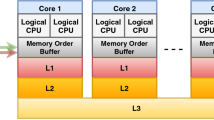Abstract
Hardware performance counters (HPCs) are present in most modern processors and provide an interface to user-level processes to monitor their performance in terms of the number of micro-architectural events, executed during the process execution. In this paper, we analyze the leakage from these HPC events and present a new micro-architectural side-channel attack that observes the number of instruction counts during the execution of an encryption algorithm as side-channel information to recover the secret key. This paper explores the fact that the instruction counts can act as a side channel and then describes the instruction profiling attack (IPA) methodology with the help of two block ciphers, namely AES and CLEFIA, on Intel and AMD processors. We follow the principles of profiled instruction attacks and show that the proposed attack is more potent than the well-known cache timing attacks in literature. We also perform experiments on ciphers implemented with popular time fuzzing schemes to subvert timing attacks. Our results show that while the countermeasure successfully stops leakages through the timing channels, it is vulnerable to the instruction profiling attack. We validate our claims by detailed experiments on contemporary Intel and AMD platforms to demonstrate that seemingly benign instruction counts can serve as side channels even for block cipher implementations that are hardened against timing attacks. In addition to it, we present detailed experimentation to analyze the rationale behind the attack and also explore the performance of IPA on a countermeasure designed to subvert the cache-based attacks considering a case study on CLEFIA.







Similar content being viewed by others
References
Aciiċmez O (2007) Yet another microarchitectural attack:: exploiting i-cache. In: Proceedings of the 2007 ACM workshop on computer security architecture, pp 11–18. ACM
Acıiċmez O, Schindler W, Koċ ĊK (2007) Cache based remote timing attack on the aes. In: Cryptographers’ track at the RSA conference, pp 271–286. Springer
Barreto P. (2003) The aes block cipher in c++. website
Bernstein DJ (2005) Cache-timing attacks on aes
Bhattacharya S, Rebeiro C, Mukhopadhyay D (2013) Unraveling timewarp: What all the fuzz is about?. In: Proceedings of the 2nd International Workshop on Hardware and Architectural Support for Security and Privacy, pp 8. ACM
Cox M, Engelschall R, Henson S, Laurie B et al (2002) The openssl project. Google Scholar
Dongarra J, Jagode H, Moore S, Mucci P, Ralph J, Terpstra D, Weaver V Performance application programming interface
Granger R, Page D, Stam M (2005) Hardware and software normal basis arithmetic for pairing-based cryptography in characteristic three. IEEE Trans Comput 54(7):852–860
Guide P (2011) Intel® 64 and ia-32 architectures software developer’s manual. Volume 3B: System programming Guide, Part 2
Levon J, Elie P (2004) Oprofile: a system profiler for linux
Liu F, Yarom Y, Ge Q, Heiser G, Lee RB (2015) Last-level cache side-channel attacks are practical. In: 2015 IEEE symposium on security and privacy (SP), pp 605–622. IEEE
Martin R, Demme J, Sethumadhavan S (2012) Timewarp: rethinking timekeeping and performance monitoring mechanisms to mitigate side-channel attacks. pp 118–129. ACM
Mukhopadhyay D, Chakraborty RS (2014) Hardware security: design, threats, and safeguards. Chapman and Hall/CRC, Boca Raton
Neve M, Seifert JP, Wang Z (2006) A refined look at bernstein’s aes side-channel analysis. In: Proceedings of the 2006 ACM symposium on information, computer and communications security, pp 369–369. ACM
Nyberg K (1996) Generalized feistel networks. In: International conference on the theory and application of cryptology and information security, pp 91–104. Springer
Osvik DA, Shamir A, Tromer E (2006) Cache attacks and countermeasures: the case of aes. In: Cryptographers’ track at the RSA conference, pp 1–20. Springer
Paar C (1994) Efficient vlsi architectures for bit-parallel computation in galois fields. PhD Thesis, Inst. for Experimental Math., Univ. of Essen
Rebeiro C, Mondal M, Mukhopadhyay D. (2010) Pinpointing cache timing attacks on aes. In: 23rd international conference on VLSI design, 2010. VLSID’10., pp 306–311. IEEE
Rebeiro C, Mukhopadhyay D (2011) Cryptanalysis of clefia using differential methods with cache trace patterns. In: Cryptographers’ track at the RSA conference, pp 89–103. Springer
Rebeiro C, Mukhopadhyay D, Bhattacharya S (2014) Timing channels in cryptography: a micro-architectural perspective. Springer
Rebeiro C, Mukhopadhyay D, Takahashi J, Fukunaga T (2009) Cache timing attacks on clefia. In: International conference on cryptology in India, pp 104–118. Springer
Shirai T, Shibutani K, Akishita T, Moriai S, Iwata T (2007) The 128-bit blockcipher clefia. In: International workshop on fast software encryption, pp 181–195. Springer
Standaert FX, Malkin TG, Yung M (2009) A unified framework for the analysis of side-channel key recovery attacks. In: Annual international conference on the theory and applications of cryptographic techniques, pp 443–461. Springer
Standard AE (2001) Federal information processing standards publication 197. FIPS PUB, pp 46–3
Wang X, Karri R (2013) Numchecker: detecting kernel control-flow modifying rootkits by using hardware performance counters. In: 2013 50th ACM/EDAC/IEEE design automation conference (DAC), pp 1–7. IEEE
Wang X, Karri R (2016) Reusing hardware performance counters to detect and identify kernel control-flow modifying rootkits. IEEE Trans Comput Aided Des Integr Circuits Syst 35(3):485– 498
Wang X, Konstantinou C, Maniatakos M, Karri R (2015) Confirm: Detecting firmware modifications in embedded systems using hardware performance counters. In: Proceedings of the IEEE/ACM international conference on computer-aided design, pp 544–551. IEEE Press
Wiki P (2015) perf: Linux profiling with performance counters
Author information
Authors and Affiliations
Corresponding author
Rights and permissions
About this article
Cite this article
Alam, M., Bhattacharya, S., Sinha, S. et al. IPA: an Instruction Profiling–Based Micro-architectural Side-Channel Attack on Block Ciphers. J Hardw Syst Secur 3, 26–44 (2019). https://doi.org/10.1007/s41635-018-0060-3
Received:
Accepted:
Published:
Issue Date:
DOI: https://doi.org/10.1007/s41635-018-0060-3




